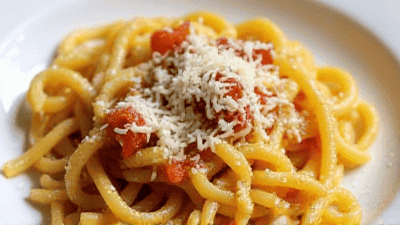
Italian cuisine is beloved around the world, and pasta is arguably its most iconic component. From simple spaghetti aglio e olio to elaborate lasagna alla bolognese, pasta dishes are an integral part of Italian culture and cooking. But what makes authentic Italian pasta truly special?
The Origin of Pasta
Pasta has a long and storied history that dates back to ancient civilizations. While many countries claim to have invented pasta, historical evidence suggests that it originated in Italy. The first known reference to pasta was in the writings of the Sicilian poet Horace in the first century BC. Over the centuries, various regions in Italy developed their own unique styles and shapes of pasta, each with distinct culinary traditions.
Types of Pasta: An Overview
Before diving into the secrets of authentic pasta dishes, it's important to understand the various types of pasta. In Italy, pasta is classified into two main categories: fresh pasta and dried pasta.
Fresh Pasta
Fresh pasta is made from a simple mixture of flour and eggs. It has a tender texture and is typically used in dishes that require a delicate touch. Fresh pasta is commonly found in northern Italy and is used to make various shapes, such as:
- Tagliatelle: Long, flat ribbons often served with hearty sauces like ragù.
- Tortellini: Small, stuffed pasta rings, usually filled with meats or cheese.
- Fettuccine: Similar to tagliatelle but slightly thicker, often paired with creamy sauces.
Dried Pasta
Dried pasta, made from durum wheat semolina and water, has a firm texture and is more versatile than fresh pasta. It is commonly used in various dishes and comes in a wide range of shapes, such as:
- Spaghetti: Thin, long strands that are a staple in many Italian households.
- Penne: Short, tube-shaped pasta often used in baked dishes or with sauces.
- Fusilli: Spiral-shaped pasta that holds onto sauces beautifully.
Each shape of pasta serves a unique purpose and pairs best with specific types of sauces and ingredients. Understanding these pairings is key to creating authentic Italian pasta dishes.
The Role of Ingredients
The quality of ingredients plays a vital role in the authenticity of Italian pasta dishes. Traditional Italian cooking emphasizes using fresh, seasonal, and local ingredients to enhance flavors. Here are some essential ingredients that you should consider:
Flour
The type of flour used in pasta making is crucial. For fresh pasta, "00" flour is commonly used. This finely milled flour produces a smooth dough that results in tender pasta. For dried pasta, durum wheat semolina is preferred because of its high gluten content, which helps maintain the pasta's shape during cooking.
Eggs
Eggs are a key ingredient in fresh pasta. They add richness, flavor, and color to the dough. The number of eggs used can vary depending on the recipe and the desired texture of the pasta.
Water
Water is essential for hydrating the flour in both fresh and dried pasta. The quality of water can also affect the dough's consistency, so using clean, fresh water is best.
Sauce Ingredients
The sauce is the heart of any pasta dish. Some classic ingredients for Italian pasta sauces include:
- Olive oil: Extra virgin olive oil is a staple in Italian cuisine, adding richness and flavor.
- Tomatoes: Fresh or canned tomatoes are essential for many sauces, including marinara and arrabbiata.
- Cheese: Parmigiano-Reggiano and Pecorino Romano are two of the most commonly used cheeses in Italian cooking.
- Herbs: Fresh herbs like basil, oregano, and parsley add aromatic flavor to pasta dishes.
Essential Techniques for Cooking Pasta
Cooking pasta may seem straightforward, but there are specific techniques to ensure it turns out perfectly every time. Here are some essential tips for cooking pasta the Italian way:
Use Plenty of Water
To cook pasta properly, use a large pot of boiling salted water. The general rule is to use about 4-6 quarts of water for every pound of pasta. This helps the pasta cook evenly and prevents it from sticking together.
Don't Skimp on Salt
Salting the water is crucial as it enhances the pasta's flavor. Use about 1-2 tablespoons of salt per gallon of water. The water should taste slightly salty, like the sea.
Al Dente Cooking
Italian pasta is typically cooked "al dente," which means "to the tooth." This means the pasta should be cooked until it is firm but not hard. It will continue cooking slightly after being drained, so it is essential to taste the pasta a minute or two before the package instructions indicate.
Save Some Pasta Water
Before draining the pasta, reserve a cup of the cooking water. This starchy water can be added to sauces to help them adhere to the pasta better and create a silky texture.
Toss, Don’t Rinse
After draining the pasta, do not rinse it. Rinsing washes away the starch that helps the sauce cling to the pasta. Instead, directly toss the pasta with the sauce in the pan for the best results.

Pairing Pasta with Sauces
One of the secrets to authentic Italian pasta dishes lies in the perfect pairing of pasta shapes and sauces. Here are some classic combinations to consider:
Spaghetti alla Marinara
Spaghetti is often paired with a simple tomato sauce, known as marinara. Made with ripe tomatoes, garlic, and fresh basil, this sauce highlights the flavors of the pasta without overpowering it.
Fettuccine Alfredo
Fettuccine is best served with creamy sauces. Fettuccine Alfredo, made with heavy cream, butter, and Parmigiano-Reggiano, creates a rich and decadent dish that showcases the pasta's thickness.
Penne Arrabbiata
Penne, with its tubular shape, is perfect for hearty sauces like arrabbiata, which features garlic, tomatoes, and spicy red pepper flakes. The sauce clings beautifully to the ridges of the pasta.
Lasagna Bolognese
Lasagna is a layered dish that features sheets of pasta alternating with rich meat sauce, béchamel, and cheese. Traditionally, lasagna uses a wide flat pasta to create depth in each layer.
Exploring Regional Variations
Italian cuisine is diverse, with each region boasting its own pasta dishes and cooking techniques. Here are a few regional pasta specialties that showcase the secrets of authentic Italian cooking:
Northern Italy: Pesto Pasta
In the north, particularly in Liguria, you will find the famous pesto alla Genovese sauce, made with fresh basil, garlic, pine nuts, Parmigiano-Reggiano, and olive oil. This aromatic sauce is often enjoyed with trofie or trenette pasta.
Central Italy: Cacio e Pepe
In Rome, the classic dish cacio e pepe is a simple yet flavorful combination of spaghetti, Pecorino Romano cheese, and black pepper. The cheese melts into a creamy sauce with the help of pasta water, creating a delicate flavor profile.
Southern Italy: Pasta alla Norma
Pasta alla Norma hails from Sicily and uses eggplant as its star ingredient. The dish combines pasta with a tomato sauce, sautéed eggplant, basil, and ricotta salata, showcasing the flavors of the Mediterranean.
Tips for Creating Your Own Authentic Pasta Dishes
Now that you understand the secrets behind authentic Italian pasta, here are some tips for creating your own delicious dishes at home:
Embrace Seasonal Ingredients
Choose fresh, seasonal ingredients to create your pasta dishes. Visit local farmers' markets to find the best produce, and let these ingredients guide your recipes.
Experiment with Flavors
Don’t be afraid to experiment with different sauces, cheeses, and herbs. Authentic Italian cuisine is all about balance and flavor, so play around with different combinations.
Master the Dough
Practice makes perfect. If you are making fresh pasta, take the time to master the dough. Adjust the ratios of flour and eggs until you find the consistency that works best for you.
Use High-Quality Ingredients
Invest in high-quality ingredients, especially when it comes to olive oil, cheese, and tomatoes. The flavors of your pasta dishes will significantly improve with quality ingredients.
Don’t Rush the Cooking Process
Italian cooking is about patience and care. Take your time when preparing sauces and pasta dishes. Allow flavors to develop fully, and engage with the cooking process.
Conclusion
Authentic Italian pasta dishes are a celebration of simple ingredients, time-honored techniques, and regional traditions. By understanding the origins, types, ingredients, and culinary practices of Italian cooking, you can unlock the secrets to creating your own delicious pasta dishes at home. Whether preparing a classic spaghetti alla marinara or experimenting with a modern twist, the joy of making and sharing pasta remains a cherished tradition in Italian culture. So gather your loved ones, roll up your sleeves, and enjoy the art of Italian pasta cooking.



